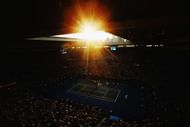Over the years, it's been noticed that the first Grand Slam of the year, the Australian Open, tends to produce the most memorable matches. One prime example being the 2012 final where Novak Djokovic & Rafael Nadal battled tooth and nail for a total of five hours and fifty-three minutes.
That match will be etched in the memory of fans forever. There are quite a few possible reasons for Melbourne to be able to produce classic matched time and again. Is it the surface? Or the weather? Or maybe the fans? Let us find out -
#1 The surface
Until 2007, the Australian Open was using the Rebound Ace surface, which was replaced by the Plexicushion surface from the following year. Players complained of the Rebound Ace surface becoming too sticky at high temperatures, a thing which is commonplace in Melbourne at this time of the year.
The Plexicushion surface was expected to be slightly slower than the Rebound Ace surface that was in play before. But players like Federer described the surface as being "slow". This led to the rallies becoming longer, making it a battle of attrition for the players. Immediate effect was seen at the 2008 Australian Open, as a match involving Lleyton Hewitt and Marcos Baghdatis ended at 4:34 AM.
The slowness of the courts is also a very plausible reason for the recent Djokovic domination in Australia, as it perfectly suits his game. And most would agree that the thrill associated with Grand Slam matches is derived from the length of the match, given that the quality of tennis on display is good, of course.
#2 The scheduling
With the tournament being scheduled during just the third week of the year, the players come in fresh right after the off-season, resulting in a definite increase in the quality of tennis. Also, players want to do well here in Australia as it sets the tone for the rest of their seasons.
A good start in Australia provides players with the perfect momentum required to do well later on in the year. Thus, there is always that extra motivation from the players' side to do well here.
Another aspect involved here is that a lot of top players are rusty going into this tournament, as it's just the beginning of the year. This has caused them trouble in the early rounds against players that they would have otherwise dispatched relatively easily.
#3 The fans
Australian fans are known to be a passionate lot. Not only do they support Australian players to the absolute limit, they are enthusiastic supporters of good tennis as well. They are loud, a far cry from the sophisticated crowds that we see at, say, Wimbledon.
This brings a different dimension to the game, adding to the excitement and interest. The Australian Open is known to draw in record number of people every year. And one is sure to be devoid of a partisan crowd, unless of course if an Australian player or Federer is playing. This helps a lot in boosting the players' morale, and we have witnessed some of the most epic encounters here.
#4 The weather
The Australian Open is widely regarded as the hottest Grand Slam of the year. And rightly so. The temperatures hover in the late 20's and early 30's. Temperatures can sometimes exceed 40, which is when the "Extreme Heat Policy" comes into the picture. Play is stopped on outside courts, while the roofs on Rod Laver Arena, Hisense Arena, & Margaret Court Arena are closed.
Since tennis players are generally used to playing in cooler temperatures, the Aussie Open becomes just like a "survival of the fittest" contest. And it's exactly what a sport should be. In the 2002 Women's Singles final, Martina Hingis lost to Jennifer Capriati after being a set and 4-0 up, squandering 4 match points.
After the match, she said, "My legs stopped functioning. The brain still wanted it, I wanted to run, get to the ball and play, but I felt like my body couldn't cope with what my brain told it to do.”
Let's hope that Melbourne Park continues its tradition of producing breathtaking matches this year as well!



